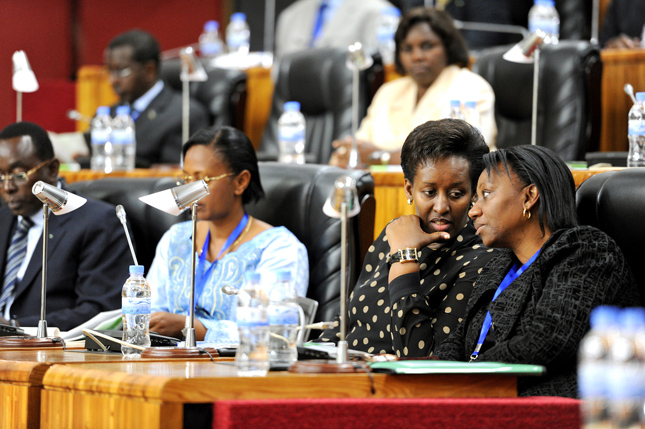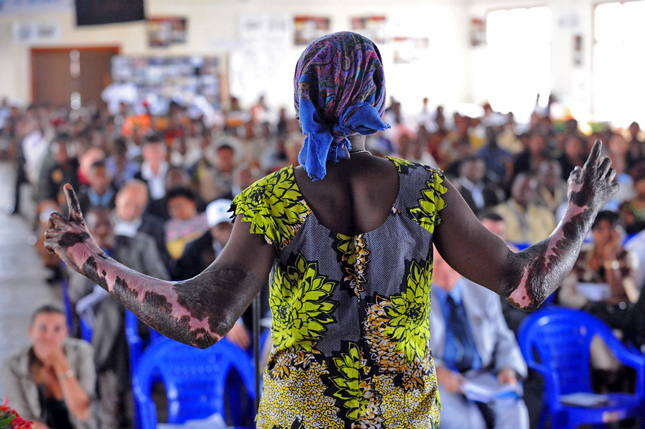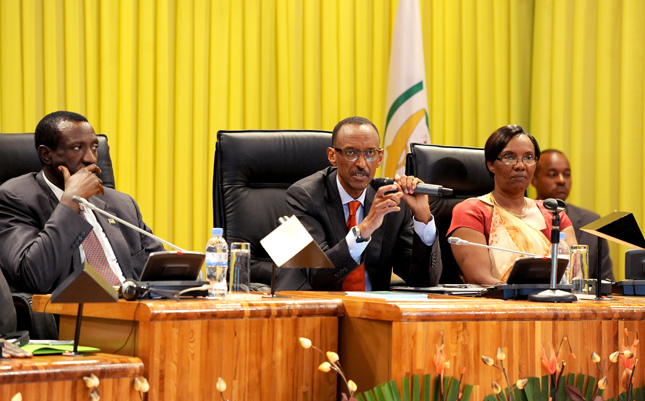-
Empowerment Without Equity? The Uncertain Progress of Rwanda’s Female Peace-Builders
October 20, 2014 By Sarah Meyerhoff
“During the liberation war,” Rwandan President Paul Kagame said in a 2010 speech, “soldiers used to sing a song praising the mothers who had carried them on their backs as babies, nurtured them, and taught them the values that ultimately informed the vision for this nation.”
“Empowering women and ensuring gender equality,” he said, “ultimately enriches communities and entire nations. This is something that we as Rwandans understood long before gender equality became fashionable or the catch-phrase in development discourse.”
Only 20 years removed from one of the most shocking bouts of violence in modern history, Rwanda is a fascinating test for the role of women in post-conflict recovery and development.
The small central African country’s recovery from genocide has been remarkable and is in many ways built on women’s leadership. Rwandan women currently hold the highest percentage of parliamentary seats of any country in the world (64 percent), and there have been efforts to improve women and girl’s education, health, and socio-economic status across the country.
But it is difficult to determine whether the reality of Rwandan women is as rosy as the rhetoric that surrounds them. The central place of women in recovery is the product of conscious efforts by the controversial Kagame and his party, the Rwandan Patriotic Front (RPF), who have tightly controlled political power since the genocide.
While on the surface their efforts have been effective at legitimizing female leadership and participation in peace-building, there’s evidence that women – politicians and everyday citizens alike – have been unable to transcend rhetoric to achieve real equity, and that the very ideas championed by the RPF to encourage women’s leadership have closed doors for women even as they’re opened.
From the Wreckage
After the 1994 genocide, during which roughly a million people were killed in less than 100 days, women comprised an astounding 70 percent of Rwanda’s population. Already charged with the bulk of agricultural work (they performed nearly 70 percent of cultivation nationally), they also became the majority of the nation’s heads of household, caregivers, and labor. According to a 2004 report from the National Unity and Reconciliation Commission, women took the lead on burying bodies, rebuilding infrastructure, and securing food and water where social services had deteriorated.
In addition to these responsibilities, many Rwandan women carried scars of their own. Sexual violence was wielded as a weapon of war, and anywhere between 250,000 and 500,000 women were raped. Nearly a half million children were orphaned during the violence, and nearly 20,000 were born as a result of rape, according to the UK Survivor’s Fund.

The RPF, the ruling party since halting the genocide and coming to power in 1994, has repeatedly cited the difficulties that the genocide imposed on women as reason for their participation in the peace process and development, according to a 2004 study conducted by the UN. Starting in the late 1990s, the new government – which even then boasted significant numbers of female leaders – made legislative strides to empower women, including protecting women’s rights to own and inherit land, as well as open bank accounts. In 2007, Kagame declared increasing access to voluntary family planning his number one priority and kicked off a government campaign that improved contraceptive prevalence rate for women dramatically.
Gender quotas on political positions are a centerpiece of RPF’s efforts. The 2003 constitution mandates neither gender can comprise less than 30 percent of any decision-making body. Since the implementation of these quotas, women have become leaders within Gacaca courts (the traditional justice system at the heart of the reconciliation process), local-level governance structures, and most notably, national government, surpassing the requirement in many cases. With more than 6 of 10 lower house parliamentary seats held by women after the 2013 elections, Rwanda’s female participation rate was the first to cross 50 percent and is the highest of any parliament in the world.
Powerful Mothers Make Powerful Leaders
The unique experience of Rwandan women is widely seen as a political advantage.
A 2006 UNICEF study by Elizabeth Powley on the impact of female lawmakers found that “both male and female parliamentarians cited women’s experience as mothers as central to not just their motivation, but also their performance as parliamentarians.” Female leadership was understood as being heavily influenced and – more importantly – improved by women’s roles as mothers and providers.
Rwandan women hold the highest percentage of parliamentary seats anywhereOverwhelmingly, as the study notes, politicians and citizens viewed those characteristics as innate, pointing to women’s “natural tendencies” toward being nurturing, caring, and peaceable and deeming it “an asset for legislators.”
Following the genocide, invoking imagery of mothers was a culturally appropriate and effective way to empower women and legitimize their leadership within households, communities, and national government, explains Shirley Randell, founding director of the Kigali-based Center for Gender, Culture and Development, in a 2013 ethnographic study.
Randell, who has worked on gender mainstreaming for numerous development organizations, found that RPF politicians deliberately tapped into pre-colonial, indigenous imagery of mothers as powerful and revered to not only reinforce their new roles, but also frame women as life-givers, nurturers, and mediators who are more trustworthy, attuned to the needs of the vulnerable, and fit to promote peace than their male counterparts. This also served as way to bring equality to the fore of national dialogue without discussing ethnicity.
By reinforcing the idea that women have a natural advantage in understanding and championing the protection of other women and children, the RPF’s efforts may have helped female lawmakers get elected. Women indeed played a significant role in the passage of laws on inheritance equality and violence against children in the transitional government. Most notably, the Forum of Women Parliamentarians spearheaded a major 2008 law against gender-based violence.
Ladder or Cage?
“The question remains, however,” writes Randell, “whether in the next generation, the exalted role of mother, which has facilitated such strong engagement in the social and political life of the country, will function more like a ladder or a cage.”
The desire to emphasize women’s roles as caregivers, cultivators, and resource managers in post-conflict situations is understandable, writes Hunter College Professor Robert Jenkins. But when policymakers and development groups frame those capacities as natural, rather than as products of larger social and political forces, they can actually disenfranchise women.
Parliamentarians are valued more for their status as role models than lawmakers“Perpetuating a simplistic view of women in conflict settings as more ‘nurturing’ and ‘peaceful’ can not only strip women of their agency and reinforce patriarchal values, but also result in roll-backs and marginalization for women in the peacebuilding phase,” a UN Women report concludes.
For example, Powley found that among peers, Rwandan women parliamentarians are valued more for their status as role models than lawmakers. Additionally, expectations that women feminize the political sphere, both by softening their male peers and advocating above all for women and children, can limit their participation on other issues. Monde Muyangwa, director of the Wilson Center’s Africa Program, recently explained that these perceptions can “ghettoize” gender issues, segregating female lawmakers into a narrow range of policy areas.
Furthermore, changes in national leadership have not always translated to gains for most women.
Thirty-one percent of Rwandan women have experienced gender-based violence from a partner or husband, and failure to adequately fulfill household roles is frequently cited as justification, according to the 2010 Demographic and Health Survey. With an additional three hours of farming work on average, as well as household chores and childcare, women in rural parts of Rwanda work on average twice as long as men each day (15.5 hours), the Ministry of Agriculture and Animal Resources found in its 2010 gender strategy framework.
These responsibilities often cause women to miss out on local reconciliation dialogues as well as sensitization campaigns that inform them of their newly acquired rights. And although Rwanda’s gender parity at enrollment in primary and secondary school is often touted, the extra responsibilities carried by young girls cause many to miss or drop out of school after enrolling, leading to overall poorer female performance in primary and secondary education.
Former Wilson Center Fellow Marc Sommers on ‘Stuck: Rwandan Youth and the Struggle for Adulthood’ (interviewed in 2012) As a result, Rwandan women remain disproportionately poor and unable to access the same career paths as men. The Ministry of Agriculture estimates that 44 percent of female-headed households live in extreme poverty compared to 35 percent of male-headed households. Additionally, men seem to be exiting subsistence farming much faster than women – the national percentage of non-wage employment fell from 73 percent to 64 percent between 2006 and 2011, according to the African Development Bank, but the percentage among women decreased by only 3. In rural areas, the number of women in non-wage family work actually increased over the same period.
“Extensive research with female and male youth strongly suggests that the much-hailed advances for Rwandan women haven’t reached many female youth,” says Marc Sommers, a former Wilson Center fellow and author of Stuck: Rwandan Youth and the Struggle for Adulthood. “Even the land inheritance reforms may have unintentionally limited female youth options.”
Jennie Burnet, a professor of anthropology at the University of Louisville, found that women’s increased access to leadership positions has fanned tensions between men and women and driven up rates of gender-based violence within families. Male interviewees felt that women’s participation in local-level councils, civil society groups, and reconciliation dialogues upset traditional household roles and prevented women from allocating enough time toward providing livelihoods, wrote Burnett in a 2011 article published in Politics and Gender.
In Randell’s study, even female lawmakers reported similar experiences of inordinate household duties and gender-based violence.
The Kagame Question
Many observers remain deeply divided on the ultimate success of women leaders in Rwanda. While on one hand Rwanda’s experience seems to validate the idea that women have special roles to play in post-conflict environments, on the other, even after two decades and higher ratios of women in leadership than anywhere else on earth, women face many of the same inequalities they do elsewhere.

The biggest caveat may be President Paul Kagame. Opinions about Rwanda’s recovery often come down to whether one considers him an oppressive autocrat or a modernizing technocrat. While some herald the gender quotas as the keystone to a nascent democracy, others dismiss them as part of a cynical and ultimately superficial effort to appeal to both Rwandan citizens and Western donors.
The 2008 GBV law was the first legislation to be introduced and passed since parliament’s reestablishment
The 2008 gender-based violence law was a milestone not only for its protections for women but also because it was the first piece of legislation to be introduced and passed solely by members of parliament since its 2003 reestablishment. The vast majority of laws are introduced by the president and passed by the legislature.
The implications of Kagame’s leadership and the gender stereotypes that seem to have followed Rwandan women on their ascent to power are unclear. Is a centralized authority essential to getting women involved in peacebuilding? Can narratives deployed by the state eventually increase accountability by giving women legitimacy even if they also perpetuate stereotypes?
The reality may be somewhere in between.
“Regardless of whether the RPF served its own ends through the increased protection of women’s rights and the greater representation of women in government,” Burnet concluded in her findings, “these policies could lead to transformations in political identities, subjectivities, and agencies and might pave the way for effective engagement in democratic governance, should it emerge.”
The ultimate effect of the ascent of Rwandan women leaders, then, may not be measured immediately, but over time. Moves towards gender equity, however small, are hard to reverse, and as the possibilities for women expand, so might their ability to unravel the remaining obstacles to a more inclusive and equitable society for all Rwandans.
Sources: African Development Bank, Government of Rwanda, Harvard Kennedy School Review, Human Rights Watch, National Institute of Statistics of Rwanda, Politics and Gender, Rwandan Ministry of Agriculture and Animal Resources , Rwandan National Unity and Reconciliation Commission, Women Under Siege Project, U.K. Survivor’s Fund, UN Women, UNICEF, UTS Cosmopolitan Civil Societies Journal.
Photo Credit: The 2012 National Dialogue (Umushyikirano), courtesy of The Government of Rwanda; A Rape Survivor Shares her Story in Gisenyi, Rwanda, courtesy of flickr user Julian Harneis; President Kagame leading discussions at the 9th National Dialogue at Parliament, courtesy of The Government of Rwanda.
Topics: Africa, conflict, democracy and governance, development, featured, gender, livelihoods, Rwanda, security, video
 A Publication of the Stimson Center.
A Publication of the Stimson Center.





